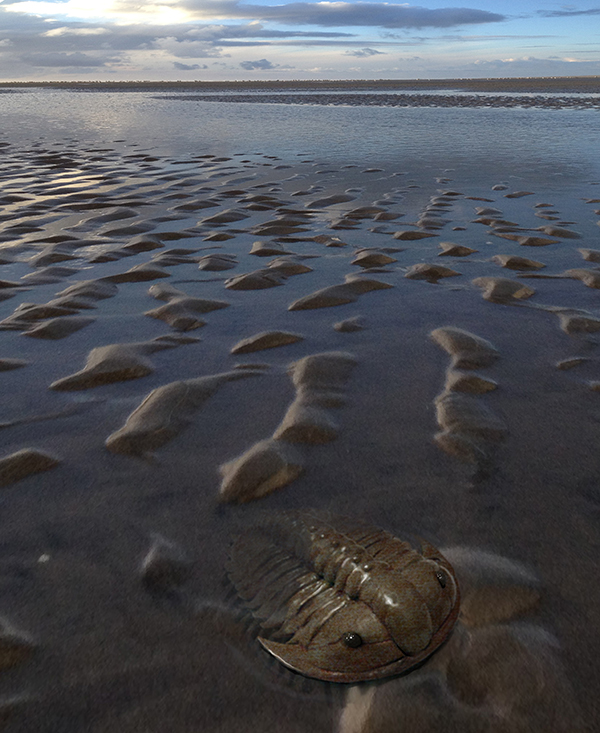
by Mary Caperton Morton Monday, June 23, 2014

Artist's rendering of trilobites on an Early Cambrian tidal flat. Trilobites first appeared about 520 million years ago and thrived for 270 million years until the end-Permian extinction, making them one of the most successful lineages to ever live. Kathleen Cantner, AGI.
During the Cambrian, when trilobites thrived in Earth’s early oceans, the continents were devoid of animal life. “The Cambrian explosion was an open marine event,” says Gabriela Mángano, a geologist at the University of Saskatchewan in Saskatoon, and lead author of the new study, published in Geology. “The typical story is that colonization of the terrestrial settings didn’t happen until the middle of the Paleozoic with organisms moving from the sea, into brackish water, then freshwater and then onto land.”
Based on a set of trace fossils discovered in Lower Cambrian rocks just outside Knoxville, Tenn., that appear to record trilobite tracks crisscrossing a tidal flat, Mángano and colleagues propose that trilobites may have been among the first animals to foray into the intertidal zone. This transition would have promoted the development of a rich intertidal community that may have served as support for animals exploring more inland areas — a sort of “bridge” between the ocean and the land. “We’re investigating the idea of a direct line of landward colonization by way of the tidal flats,” she says. Other terrestrialization theories suggest that animals moved from the sea, through estuaries and brackish water into freshwater and then onto land.
The finding will be controversial, Mángano admits, because “most people consider trilobites to be fully marine organisms.” But the Tennessee locality appears to preserve traces of trilobite tracks marching across rocks that bear raindrops, ripples and cross-cut desiccation cracks often associated with intertidal zones. “It appears the trilobites were coming and going with the tides, feeding on microbes in the intertidal zone and then returning to the subtidal realm,” she says.
Tidal zones during the Cambrian would have looked very different from modern beaches mainly due to the lack of predators, especially birds. “In the Cambrian, tidal flats would have been a protected environment, a refugium, that would have been very attractive to marine organisms, including trilobites,” Mángano says. By “visiting the intertidal zone, trilobites colonized an underutilized ecospace, promoting the establishment of an intertidal ecosystem that may have ended up favoring the migration of other organisms onto the continent.” Thus, she says, the presence of trilobites in tidal zones supports the idea that marine organisms could have colonized the land directly from the sea, without going through a brackish to freshwater transition first, she and colleagues wrote.
But advancing their theory will require more evidence, says Duncan McIlroy, a paleobiologist at Memorial University of Newfoundland in St. Johns who was not involved with the new study. “Even if these trilobites were coming in with the tide and going back out again, that’s not really evidence for a transition onto land,” he says. Some fish “come and go with the tides, but they don’t seem to be on their way to becoming terrestrialized.”
McIlroy also isn’t convinced that the sedimentary evidence preserved at the site in Tennessee is conclusive of a tidal setting. “In my opinion, they’ve failed to demonstrate that these rocks are conclusively tidal. There’s nothing to suggest that these are anything but marine organisms living in a marine environment.”
The site could still yield more convincing evidence, McIlroy says. “Cambrian fossils and trace fossils are found in many places around the world, but we don’t have many places of this age that are tidal. This site could yield such evidence, but it needs more detailed investigation.”
Mángano and colleagues plan to keep studying the Tennessee locality to learn more about the lifestyles of Lower Cambrian trilobites. “Trace fossils often provide a more dynamic, ecological explanation of past worlds, not only in terms of the taxa present but also the new relationships and trophic webs that bloomed during transitions like the Cambrian explosion,” she says. “A site like this can really open a new window onto this world.”
© 2008-2021. All rights reserved. Any copying, redistribution or retransmission of any of the contents of this service without the expressed written permission of the American Geosciences Institute is expressly prohibited. Click here for all copyright requests.